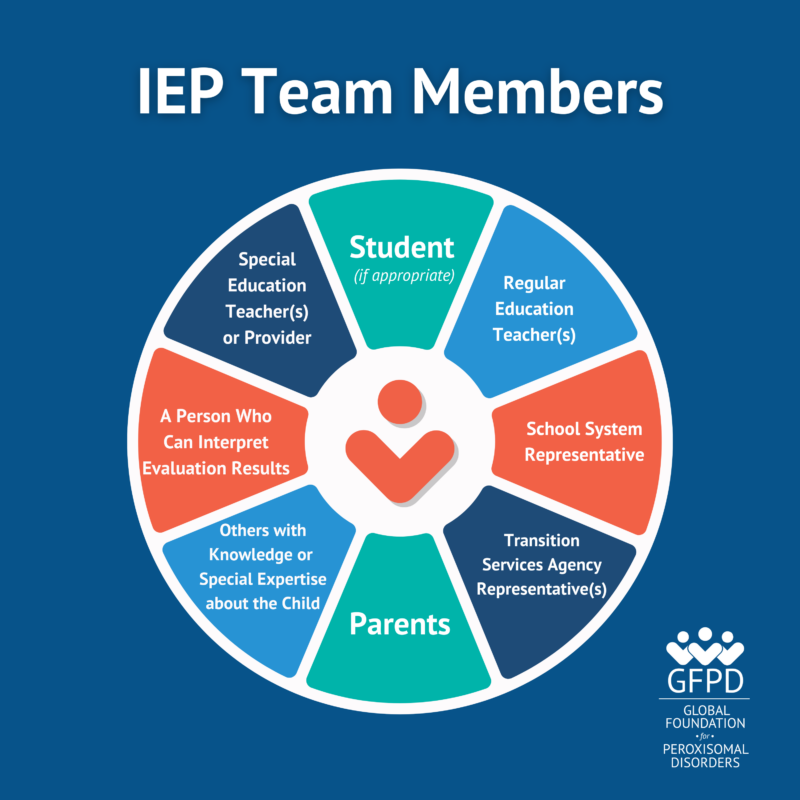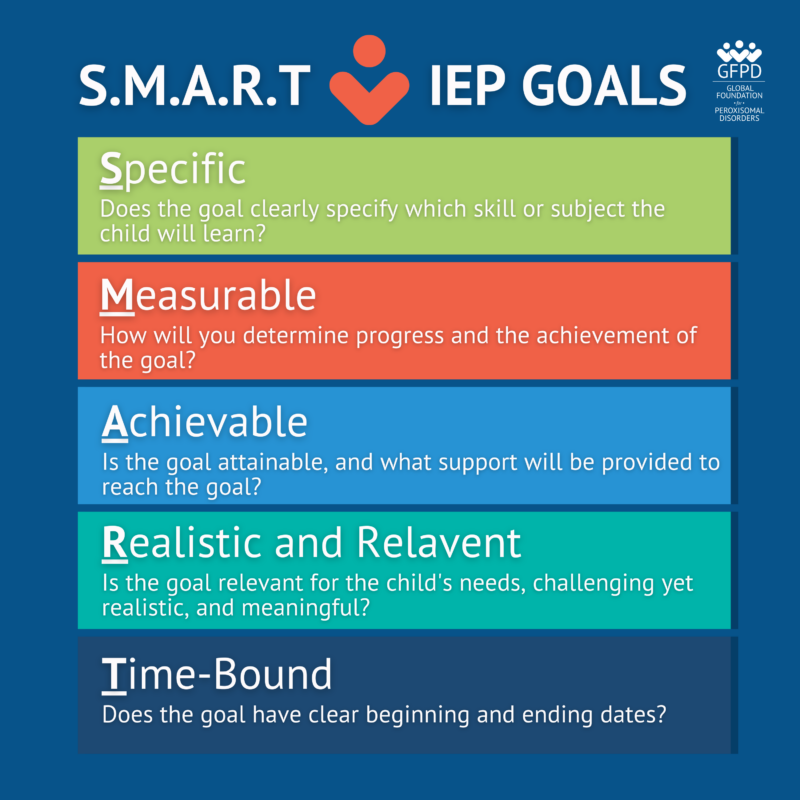As summer draws to a close in the US, families across the country are preparing for the return to school. For families with children who have peroxisomal disorders, this time of year can bring unique challenges and concerns. At the Global Foundation for Peroxisomal Disorders (GFPD), we understand the complexities that these families face and are here to provide guidance with this back to school series and support as you navigate the new school year.
As we continue this blog series, we’ve already explored the Pyramid of Learning for deafblind learners and Modifications and Accommodations. We are now discussing the importance of Individualized Education Program (IEP) before we explore the recommended techniques to be used with deafblind learners and more.
Part Three:
Individualized Education Program (IEP)
When someone new meets your child, that person is unaware of the numerous ways your child’s disability may impact them or how to successfully engage and work with them without proper guidance. An IEP serves as a roadmap, guiding these educators as they navigate working with your child.
Within the US, the Individuals with Disabilities Education Act (IDEA) is the federal law providing legal basis for eligible students with disabilities to receive a free appropriate public education (FAPE). The IEP itself is a “term outlined by IDEA to define the written document that states the disabled child’s goals, objectives and services for students receiving special education.” There are many different names for the IEP (also called the Individual Education Program, Individual Education Plan, or the Individualized Education Plan), but regardless of which term your state or school utilizes, they all have the same end-state in mind, ensuring your student receives a FAPE.
Reading the IEP should ensure those working with the student know their disability, understand its impact on their learning, can identify their present levels of performance (e.g. current abilities, skills, challenges, and strengths), and know their communication methods, goals, and what strategies, modifications and/or accommodations are necessary for learning.
IEPs are not just about meeting educational needs; they are about empowering Warriors to reach their full potential in every aspect of their life.
What’s the difference between an IEP and a 504 plan?
Both the 504 Plan and an IEP offer accommodations for students with disabilities. The 504 Plan, Section 504 of the Rehabilitation Act of 1973, assists eligible students who do not require special education services by eliminating barriers to learning due to their disability. In contrast, an IEP is a comprehensive plan or program for eligible students who need specialized instruction and related services. An IEP involves detailed annual goals, progress monitoring, reporting, and more.
Special Education is defined as “specially designed instruction, at no cost to the parents, to meet the unique needs of a child with a disability….” and encompasses a range of services. Special education services are provided in a variety of settings, including but not limited to schools, home, and transportation.
Eligibility and Determination for Special Education Services
- “Child with a Disability” determines whether your child is eligible for special education and related services under the law
- A child with a disability is not automatically eligible for special education and related services
- Parents, the state department of education, state agencies, and school district staff may request an initial evaluation of a child
- Informed parental consent must be obtained prior to the initial evaluation
- Unless a state has a statute or regulation stating otherwise, the initial evaluation and eligibility must be completed within 60 calendar days from parental consent
Who makes up the IEP Team

- Parents are an integral part of teams, able to provide critical insight to the team
- At least 1 regular education teacher
- At least 1 of your child’s special education teachers or service providers
- A qualified school district representative
- This person must be knowledgeable about general education, resources, and be able to provide or supervise special education instruction
- An individual who can interpret evaluation results
- Any other individuals who have knowledge or expertise about the child
- Parents have the option to invite others, such as professionals or family members and friends, who possess knowledge or expertise that could benefit the team
- The child, if appropriate
Team Member Participation
- Schools must take measures to ensure that one or both parents can attend the IEP Team meeting, or are provided the opportunity to participate. This involves providing sufficient advance notice and arranging the meeting at a mutually agreed time and location.
- If a date/time is presented that you cannot attend, then you should respond and request a new date/time.
- If a schedule conflict arises, it is appropriate to request a new date/time or to request a different method of attendance, such as calling in.
- An IEP meeting can proceed without the presence of parents, only if the district has made exhaustive efforts to secure their attendance and possesses detailed documentation of all communications with the parents.
- School districts must ensure that parents comprehend the IEP meeting, which includes supplying a qualified interpreter when necessary.
- Should a relevant team member be unable to attend, they must inform you beforehand, and if necessary, the meeting may need to be rescheduled to ensure their inclusion.
Click here to watch attorney Amanda Hess talk about the importance of parents understanding their rights to participate in the IEP process.

Key Components of an Effective IEP
- Comprehensive Assessment: The IEP should be based on a thorough assessment of the Warrior’s strengths, needs, and challenges. This assessment should be conducted by a team of professionals, including teachers, therapists, and medical specialists.
- Clear, Measurable Goals: The IEP should include specific, measurable goals that are tailored to the child’s unique needs. These goals should be reviewed and updated regularly, to ensure that they remain relevant and achievable.
- Regular Progress Monitoring: Ongoing monitoring and assessment are essential to track the child’s progress and make any necessary adjustments to the IEP.
- Collaboration and Communication among team members!
Prior Written Notice
School districts must provide a PWN to parent(s) before changing or refusing identification, evaluation, placement , or FAPE. If you do not receive a PWN after a meeting, then request it.
“If it was not written down, it was not said. If it was not written down, it did not happen.”
-Pete Wright
Now that you know more about what an IEP is and who participates, how do you prepare for the IEP meeting?
Ensure you allocate time to review the IEP along with any relevant documents, such as recent progress reports and assessments. Prepare a list of your notes, concerns, and questions to stay focused during discussions. If possible, obtain a draft IEP and the meeting agenda in advance, and request the addition of any necessary items to the agenda. Should you have extra information for the team, be prepared to present and discuss it.
In a future blog post, we will explore the emotions and advocacy associated with the IEP process. For the time being, think about strategies to use before the meeting that can assist in maintaining your composure and/or recognizing when you might need to ask for a break.
Additional Things to Remember
- Do not be afraid to ask questions, including asking to explain about terms you don’t know
- Transportation is also a service that can and should be discussed at an IEP meeting
- Training for parents and/or the professionals serving the student can also be addressed at the IEP meeting
- IEP’s should be individualized to each student
- Make sure you get a copy of the PWN and other IEP documents
- Do not leave a meeting early!
- IDEA requires one annual meeting, but the district or a parent can request additional meetings
Always remember that while the IEP acts as a guide for others working with your child, it is your child’s needs that are the driving force and should consistently be the focus for all team members.
As you prepare your Warrior for the new school year, remember that you are not alone. The Global Foundation for Peroxisomal Disorders is here to support you every step of the way. By understanding the PYRAMID OF LEARNING, ensuring that appropriate MODIFICATIONS AND ACCOMMODATIONS are in place, and advocating for a well-written and current IEP, you can help set the stage for a successful and fulfilling school experience for your child.
Keep an eye out for our upcoming blog post in this educational series, where we will explore recommended strategies for Deafblind Learners.
Future discussion will also cover assessments, emotional support, and advocacy, including steps to take when in disagreement with the school district’s decisions, and the implementation of deafblind interventions within the educational environment.
Written By Katie Sacra and Margaret Reimann
Sources: DRSC and Wrightslaw
Common IEP Acronyms at a Glance
| AT | Assistive Technology |
| ESY | Extended School Year |
| FAPE | Free Appropriate Public Education |
| IDEA | Individuals with Disabilities Education Act |
| IEP | Individualized Education Program |
| LRE | Least Restrictive Environment |
| PWN | Prior Written Notice |
Recommended Resources for Parents
